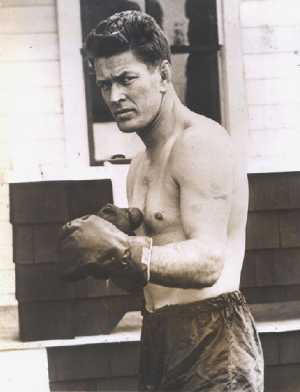 SKC Films Library SKC Films Library |
| SKC Films Library >> Recreation >> Boxing |
| Gene Tunney aka "The Fighting Marine"
James Joseph Tunney was born in New York, New York, on May 25, 1897. He became known in his family as "Gene" because his baby sister had trouble pronouncing his given name. He got his first pair of boxing gloves from his father, an amateur boxer, at the age of 10, and learned to fight in the streets. Forced to quit school as a teenager to go to work as a typist for the Ocean Steamship Company in New York City and help support his family, Tunney also gravitated toward boxing in this period, venturing nightly to the Greenwich Village Athletic Club to train, spar, and make valuable connections with people involved in the sport. In 1915, at age 18, he made his debut as a middleweight against Bobby Dawson, who he defeated by knockout in the sixth round. During Tunney's career, official decisions in boxing were outlawed in New York and other states as a means to avoid corruptive influences, so fans relied upon newspaper reporters to give them accurate accounts as to who deserved to win the fights. Eighteen of Tunney's fights would therefore officially result in "no-decisions." In his first dozen fights, however, held between 1915 and 1918, Tunney managed to go undefeated before enlisting in the United States Marine Corps on May 2, 1918. Although he served in France during the last years of World War I, Tunney never saw combat. He did, however, see plenty of action in boxing rings, and in 1919 he won the light heavyweight championship of the American Expeditionary Force in Paris. Between 1919 and 1920, Tunney scored an impressive eleven consecutive knockouts, mostly in the New Jersey area. His first notable victory did not come until 1921, however, when he scored a technical knockout against Soldier Jones as one of the undercards of the ack Dempsey-Georges Carpentier fight in Jersey City. That victory earned him a shot at the North American light heavyweight championship, which he won by defeating Battling Levinsky in a 12-round decision at Madison Square Garden in New York City on January 13, 1922. Tunney suffered the only loss of his career on May 23, 1922, when he lost the light heavyweight championship to Harry Greb in a 15-round decision. On August 22, 1922, he fought Tommy Loughran in Philadelphia. Although the 12-round match technically ended with a no-decision, the New York Times awarded their decision to Tunney. On February 23, 1923, he reclaimed the light heavyweight title by defeating Greb in a 15-round decision at Madison Square Garden. Tunney also made his debut at heavyweight in 1922, twice fighting Charley Weinert. Their first match, on August 17, ended in a no-decision that many felt Tunney deserved. In the rematch on November 29, Tunney left no doubts, with a fourth round knockout win. On June 26, 1924, he knocked out fringe contender Erminio Spalla at Yankee Stadium, and then dropped back down to light heavyweight to face aging former champion Georges Carpentier at the Polo Grounds in New York, who he defeated when the referee stopped the fight in the 15th round. On June 5, 1925, Tunney faced heavyweight Tommy Gibbons, who had never previously been knocked out. Though he was thought to be on the tale end of his career, he was still regarded as the first true test for Tunney in the heavyweight division. The "Fighting Marine" passed the test with flying colors, becoming the first to knock Gibbons out, in twelve rounds. Wins over heavyweights Jack Martin, Bartley Madden, Dan O'Dowd, and a no-decision against Johnny Risko followed. On September 23, 1926, Tunney met Jack Dempsey at Sesquicentennial Stadium in Philadelphia for a chance to take the world heavyweight championship. Having spent a lot of time watching footage of previous Dempsey matches, Tunney entered the ring fully prepared and never allowed Dempsey to score a major hit. The 10-round match ended with a unanimous decision for Tunney. Tunney spent most of the next year out of the boxing ring before agreeing to a rematch with Dempsey, which took place at Soldier Field in Chicago on September 22, 1927. As he had in the first match, Tunney dominated Dempsey for the first six rounds, but Dempsey managed to land a solid blow and knock Tunney to the canvas in the seventh. Illinois rules of the day required that a boxer go to a neutral corner after a knockdown, but Dempsey went to Tunney's corner instead. It took the referee four seconds to get Dempsey to a neutral corner and begin the 10-count, time which Tunney used to regather his senses and strength. Tunney waited until the count of "9" to get back up, completed the 10-round fight, and was declared the winner by decision. Tunney on the mat during his match against Dempsey Having defended his title, Tunney once again briefly retired from the ring. He successfully defended his title again on July 28, 1928, against Tom Heeley, and announced his full retirement two days later. After retiring from the ring, Tunney married Mary Josephine "Polly" Lauder, a wealthy steel heiress. Aside from a stint in the U.S. Navy during World War II, he spent the rest of his working as an executive of various banks, manufacturing companies, insurance firms, and a newspaper (the Toronto Globe and Mail). He also pursued his interest in literature and was the author of A Man Must Fight (1932) and the autobiographical Arms for Living (1941). He was a multi-millionaire when he died in Greenwich, Connecticut, on November 7, 1978.
SOURCES SEE ALSO |
| SKC Films Library
>> Recreation >> Boxing This page was last updated on May 25, 2017. |
